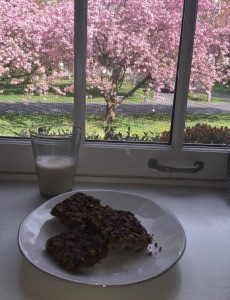Growing up in a reform Jewish household in the Midwest I had never heard of “counting of the Omer,” until my husband asked me to marry him, on a mountaintop at Shenandoah National Park. All month I felt his nervous energy. He was always in a rush — to meet my parents (during a family trip to Mexico that he crashed), to go hiking that Sunday morning (which was really inconvenient since I was moving apartments the next morning) — and to propose. I didn’t realize that he had a deadline of the second night of Passover. See, on many days of the count certain acts are forbidden —like, shaving, weddings, and dancing — as if the community is in mourning. It was either that day or he would have to wait to propose until Lag B’Omer or even — G-d forbid — Shavuot.
Flash forward eighteen years of marriage: There haven’t been a lot of counting of the Omer discussions. He’s a lawyer so he makes sure his Jewish milestones are “kosher” according to Jewish law but he’s not so strict with his everyday Judaism. We now live in the Philadelphia suburbs, with its large Jewish population so it’s more common than not to hear friends talk about the Omer. Each night from the second night of Passover until Shavuot you count the 49 days that it took the Jews to leave Egypt and walk across the desert to Mt. Sinai where Moses received the Torah. These seven weeks are a time of spiritual growth and improvement, sort of a metaphysical journey parallel to the physical journey that the ancient Jews undertook in order to be ready to receive the Torah. If you haven’t made any progress, don’t give up. You still have time.
Most of the talk during these seven weeks is less about the counting and more about Lag B’Omer, the 33rd day when Jews get a reprieve from the forbidden acts and celebrate with bon fires, food, and dancing. I’m sure that while they are cavorting round the fire, eating Israeli food of hummus & shish kebabs, and drinking beers, that they are not thinking about whose death they are commemorating: Rabbi Shimon bar Yochai, the second century author of the Zohar (which contains mystical interpretations of the Torah), and chief source of the Kabbalah.
Let’s put his life in context: the Romans, the infamous persecutors of Jews, ruled Israel. After witnessing the torture and death of his great teacher Rabbi Akiva, Rabbi Shimon bad-mouthed the Romans. One of Rabbi Shimon’s students narked on him to the Romans. He and his son fled and eventually settled down in a cave in Northern Israel where they lived for thirteen years buried naked (so that their clothes lasted longer) to their necks in the sand and studying Torah (of course). Miraculously, a carob tree grew at the foot of the cave and provided nourishment for the father and son. They survived — I guess it was that mighty combination of prayer and the nutritional power of carob — until the Emperor died and it was safe to leave the cave.
This tale is the reason that many modern day party goers eat carob at their Lag B’Omer celebrations. These carob treats of today are a long way from those carob-covered pretzels that my health-nut aunt served us in the 70s. They are much more sophisticated — carob fudge, candy brittle, fancy cakes — probably because of the growth of the health conscious food movement, specifically the vegan community. Carob can satisfy your sweet tooth and it is low in fat, high in fiber and — compared to chocolate — has no caffeine. Because I detest those supposedly good-for-you cereal bars that my kids are always crave, I made a maple and carob chip granola bar, recipe courtesy of Whole Foods, for our celebration on Thursday. Hopefully by eating this treat my kids will miraculously be nutritionally and spiritually fortified.
Maple and Carob Chip Granola Bars courtesy of Whole Food Market
Ingredients
• 4 cups quick cook oats
• 1/3 cup canola oil
• 3/4 cup pure maple syrup
• 1 teaspoon vanilla extract
• 1 cup vegan carob chips
• 1/2 cup chopped walnuts (I substituted freshly shredded coconut from a whole coconut.)
(Note: I added a teaspoon of cinnamon and 1/3 cup of carob chips. The latter was added after the mixture cooled a bit. When you initially blend the warm oats and the syrup/oil mixture, the carob chips melt. I wanted to have some whole carob chips to increase the crunch of the bars.)
Method
Preheat oven to 350°F. Spread oats onto a baking sheet and bake for 15 minutes, stirring occasionally. Meanwhile, mix together oil, syrup, vanilla, carob chips and walnuts in a large bowl. Add warm oats and stir well.
Spread oat mixture into a greased 9- x 13-inch baking dish, pressing down hard to compact it. Bake for 25 to 30 minutes, or until golden brown. Cool completely, then cut into bars.
Nutritional Info
Per Serving: Serving size: 1 bar, 250 calories (100 from fat), 11g total fat, 3g saturated fat, 0mg cholesterol, 5mg sodium, 35g carbohydrate (3g dietary fiber, 14g sugar), 4g protein

